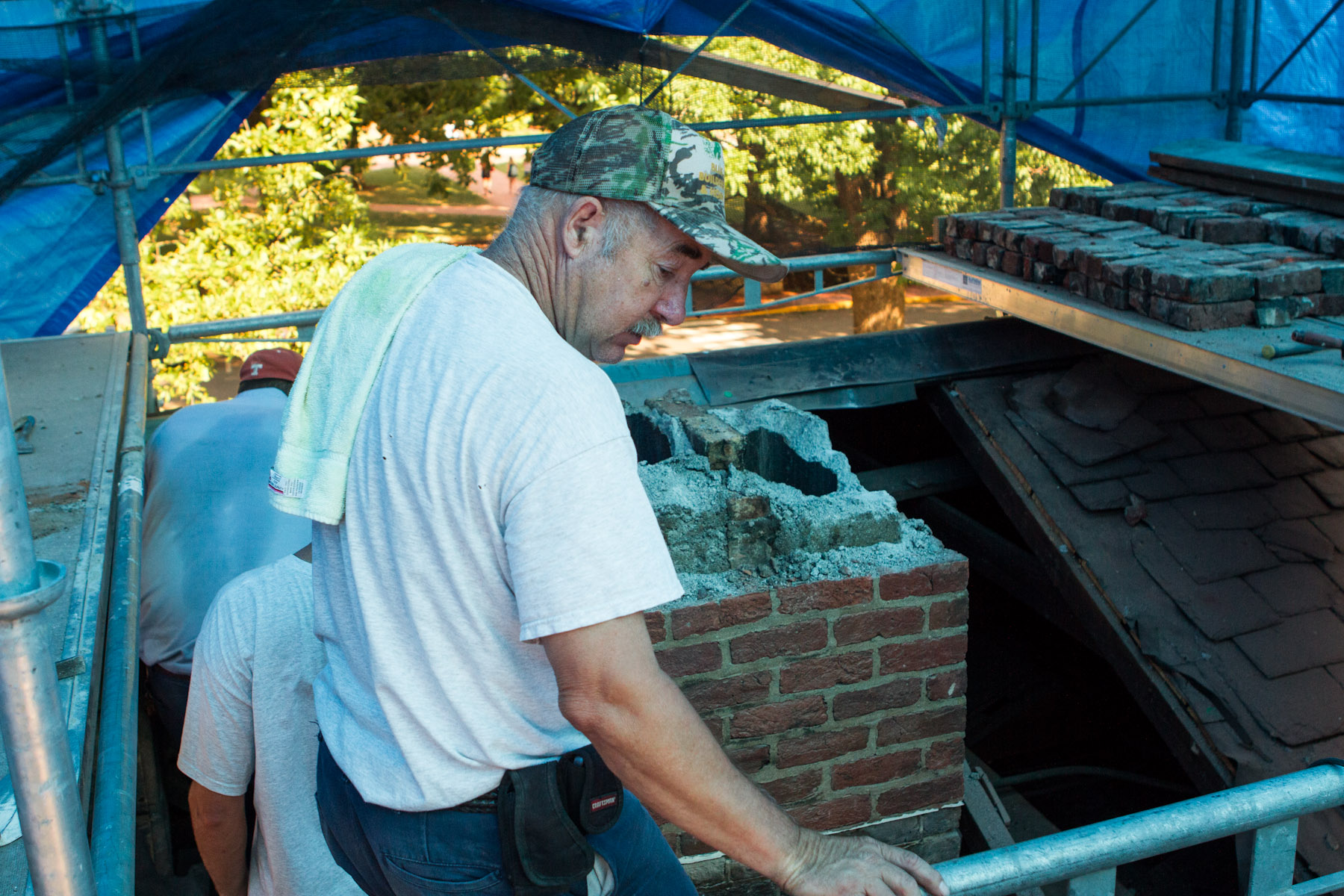Lawn and Range rooms at the University of Virginia, which date back to the University's founding in 1819 and are coveted by fourth-year and graduate students, have long had working fireplaces. And it is tradition for students to have fires in their rooms during the winter.
However, inspections performed last August detected cracks in the flue linings and chimneys, and University officials prohibited fires in the rooms until the chimneys could be repaired and a sprinkler system installed in the rooms and attics..
This summer, Facilities Management crews and contractors are trying to accomplish all the necessary repairs on the 61 chimneys with 105 flues and install a modern fire suppression system. The project, budgeted at about $3.7 million, or about $35,000 per room, has a target completion date in November. It is being funded through a combination of donations and maintenance funds.
Facilities Management crews found cracks in the chimneys during roof work on the Academical Village. A Norfolk contractor, Black Goose Chimneys, then examined all of the chimneys and fireplaces and found problems with the chimneys, flue linings, fireboxes and dampers. Black Goose recommended that students not use the fireplaces until they could be repaired, as the cracked chimneys and linings could allow fire to spread into the roofs over the rooms, where there are no firebreaks.
Joseph "Jody" Lahendro, a supervisory historic preservation architect with Facilities Management, said crews have been working inside the students' rooms while they are unoccupied, to minimize the impact on residents' lives.
"We've finished the fireplace interior repairs," he said. "The goal is to get done with the messy work, like taking out the chimney liners, which produces dust and dirt, before the students get back."
James Zehmer, the construction preservation manager, said the project is a tightly choreographed dance among the contractors, subcontractors and University craftsmen, between 50 and 60 people, to get the work done efficiently.
"With the sheer amount of work and the numbers of people, the amount of coordination is incredible," he said.
Facilities crews are going through the rooms, cutting the holes for water lines to enter and cutting away sections of the roofs to give University masons access to the chimneys. Crews from Black Goose Chimneys are breaking up the old concrete liners, which had been installed in 1991. At that time, a bladder was placed in the chimney and inflated. Once it was inflated, concrete was poured around it to form the flue lining. Once the concrete had hardened, the bladder was deflated and removed.
"That was state of the art in the early 1990s when they were installed," Lahendro said. "It was thought to be compatible with the original masonry chimneys."
This time around, the chimneys are being relined with stainless steel flues. The existing dorm room flues are simple and straight, Lahendro said, which will facilitate replacement of the old concrete linings with new stainless steel ones.
Facilities masons are repointing and in some cases rebuilding chimneys. "We found as we were opening up the roofs, that some of the chimneys were in bad enough shape we just took them down to the roof line," Zehmer said.
Masons have also repaired fireboxes and smoke chambers in the rooms.
At the same time, crews from Virginia Sprinkler Co. of Richmond, under the management of Charlottesville general contractor Martin Horn, are installing a fire suppression system in the rooms as well as in the attic spaces above them. A.G. Dillard of Troy is performing the utility work to connect sprinkler systems with underground water mains.
"By repairing the chimneys and installing the sprinklers, we have two projects going on at the same time, in the same place," Zehmer said. "Because of their experience with our historic building fabric, U.Va. carpenters and masons are making the holes in the rooms to route the new sprinkler lines."
"There is very little compromise to the structure of the room," Lahendro said. "There will be one sprinkler head in each room, above the door, served by an exposed pipe head above the door, against the wall, so we minimize intrusion into the historic space."
The exposed pipe and sprinkler head will be visible only from inside the room. Lahendro said that some of the students build structures within the room for bunks or reading space. He said these will still be allowed, as long as they do not block the fire suppression system.
Zehmer said that, although some of the work will spill over into fall, "Our end goal is to have all the chimney liners and sprinklers installed, tested and approved by Nov. 1."
It seemed a daunting task at the beginning, he said. "But it is for a good cause. Having log fires in the Lawn and Range rooms is a U.Va. tradition. Restoring this tradition shows that historic preservation at U.Va. isn't only about preserving historic buildings, it's about preserving the U.Va. student experience."
– by Matt Kelly
Media Contact
Article Information
July 26, 2012
/content/uva-lawn-and-range-chimney-repairs-are-well-under-way

